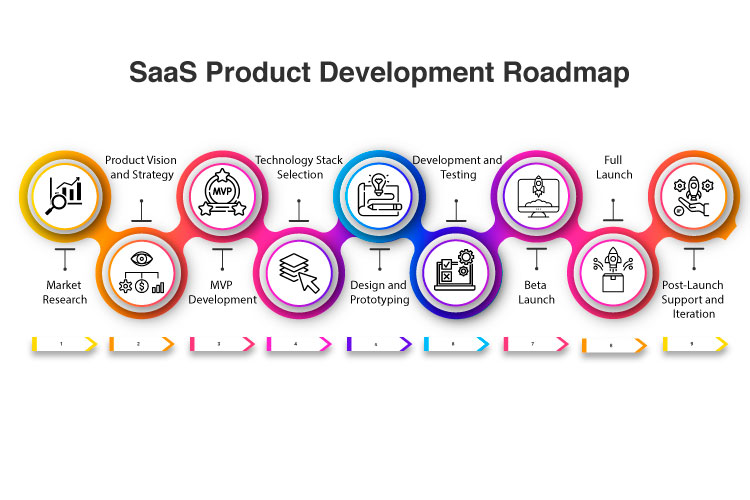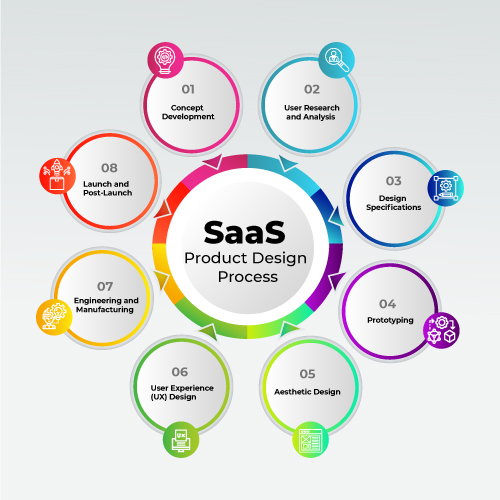Software as a Service (SaaS) has revolutionized the way businesses operate and interact with technology. As companies continue to seek innovative solutions to enhance their operations, the demand for robust and efficient SaaS products is increasing.
SaaS product development revolves around designing, building, and deploying cloud-based software applications. It starts from idea generation to actual development, to testing, market release, and beyond.
What Is SaaS?
SaaS application is software that organizations don’t have to host on-premises. It is usually maintained by a third-party service provider and made available to customers over the Internet. SAAS deployment model uses cloud infrastructure to provide a host of services.
Unlike traditional software, which requires physical installation on individual computers, SaaS applications can be accessed from anywhere, at any time, using a web browser. This model reduces the need for extensive IT infrastructure and offers flexibility in terms of updates and maintenance, which the service provider manages.
Understanding The SaaS Product Development Lifecycle Stages.
SaaS product development follows a series of stages in a structured lifecycle format, like traditional software development. The key stages include:
1. Ideation and Planning:
- The initial phase involves identifying the market need, defining the product vision, and outlining the core functionalities of the SaaS application.
- Market research and competitor analysis are crucial at this stage to ensure the product meets user demands and stands out in the market.
2. Design and Prototyping:
- During this stage, the conceptual ideas are transformed into visual representations through prototypes.
- This phase focuses on user experience (UX) design, ensuring the application is user-friendly. Feedback from potential users can be valuable in doing the design.
3.Development:
- The actual coding of the SaaS application takes place in this phase.
- Development is typically divided into frontend (client-side) and backend (server-side) components.
- Agile methodologies are often employed to facilitate development, continuous integration, and delivery.
4.Testing and Quality Assurance:
- Rigorous testing is essential to identify and rectify any bugs or issues before the product is launched.
- This phase includes various types of testing, such as unit testing, integration testing, performance testing, and security testing, to ensure the application is robust, reliable, and secure.
5.Deployment:
- Once the product passes all quality checks, it is deployed to a live environment.
- Continuous deployment practices enable frequent updates and feature releases, ensuring the product evolves in line with user feedback and market trends.
6.Maintenance and Support:
- Monitoring the application’s performance, addressing any issues that arise, and implementing new features based on user feedback.
- Effective customer support is crucial to maintaining user satisfaction and loyalty.
Informics Digital: A Leader in SaaS Implementation and SaaS development Services.
The SaaS Product Development Process.
Check out the methodology used by Informics Digital for SAAS Product Development.

1.Comprehensive Market Analysis.
The SaaS product development journey starts with thorough market research.
Understanding the target audience, identifying pain points, and analyzing competitors are crucial steps.
This comprehensive analysis ensures that the SaaS product addresses real market needs and stands out in a crowded digital marketplace.
2.Custom-Tailored Solutions.
- Delivering custom-tailored solutions that cater to the unique requirements of each client.
- By leveraging cutting-edge technologies and agile methodologies, the company develops SaaS products that are not only functional but also scalable and adaptable to future needs.
3.Agile Development Methodology.
Informics Digital adopts an agile development methodology, emphasizing progress, continuous feedback, and flexibility.
Allows rapid development cycles, timely delivery, and the ability to pivot based on client feedback or market changes.
4.Minimum Viable Product (MVP):
- MVP is a variant of a SaaS product that includes basic features to analyze initial performance per user feedback.
- MVP lowers the risk.
- It receives user feedback about UI and performance and helps to understand what improvisations to do so that the final product meets user expectations.
5.Robust Architecture Design.
- Focuse on creating robust, scalable and secure architectures that can handle varying loads and ensure seamless performance.
- By employing microservices architecture, containerization, and serverless computing, the company builds resilient systems that support business growth and continuity.
6.User-Centric Design.
- User experience (UX) is a critical factor in the success of a SaaS product. Prioritize user-centric design, ensuring that the product is intuitive, accessible and engaging.
- Through user research, prototyping, and usability testing, the company creates interfaces that enhance user satisfaction and retention.
7.Seamless Integration Capabilities.
Informics Digital excels in developing SaaS products with seamless integration capabilities, allowing them to work harmoniously with existing systems.
8.Security and Compliance.
Security is a top priority in SaaS product development. We implement stringent security measures to protect sensitive data and ensure compliance with industry standards and regulations.
From data encryption and secure authentication to regular security audits, the company leaves no stone unturned in safeguarding its clients’ interests.
9.Continuous Support and Maintenance.
The journey doesn’t end with the deployment of a SaaS product; continuous support and maintenance services are essential to ensure that the product remains up-to-date, secure, and efficient.
Regular updates, bug fixes, and performance enhancements are part of the comprehensive post-launch support offered by the company.
A Few Of The Most Important Frameworks For Developing SaaS Products.
It is a set of tools, libraries, technologies used, and best practices for creating and deploying cloud-based software applications.
The SaaS framework is more suitable than the on-premises model due to flexibility, transparency, scalability, and easier integration with third-party applications.
Some of the most common frameworks with their unique features are:
Symfony SaaS Framework, an open-source PHP framework
- Modular architecture
- Scalable
- Seamless URL routing
- Robust security
- Dynamic toolbar
ReactJS SaaS framework is an open-source frontend library for UI/UX design.
- JSX syntax
- Virtual DOM
- Cross-platform mobile development
Docker is open-ended for fast code testing and deployments.
- Containerization technology
- DevOps integration
- Allow fast CI/CD pipelines
Angular SaaS Framework, front-end.
- Vast library of components
- Cross-platform compatible
- Reactive programming
Laravel PHP SaaS Framework
- Artisan CLI
- Routing system
- Blade template engine
Vue.js, creative user interface
- Reactive data binding
- Better code reusability
- Direct integration
Django SaaS Framework
- Object-oriented database
- Customization is available
- Multi-tenancy access
SaaS Product Design Process.

Product design is the process of creating and developing new products to meet customer needs and market demands, focusing on functionality, aesthetics, and user experience.
Excellent product design offers options to users and gives a competitive edge in the marketplace.
SAAS Designing is the art of creating user-friendly and user-satisfying software. It involves crafting easy-to-navigate and visually appealing interfaces aligned with user needs.
With emerging SAAS trends in 2024, it becomes essential to engage and attract customers by giving them visually appealing and manually easing software applications so that their overall experience accelerates, and they cherish the body made.
This is the USP that the company can give, apart from basic price levels.
What Factors Can Affect The Cost Of SaaS Product Development?
Several factors affect the cost of SaaS product development:
1. Complexity and Features:
More complex features and functionalities increase development time and cost.
2. Design and User Experience:
High-quality, custom designs can add to the cost.
3. Integration Requirements:
Integrating with other systems or APIs can be resource intensive.
4. Security Measures:
Implementing robust security protocols adds to the cost.
5. Development Team Expertise:
Hiring skilled developers and specialists may be more expensive.
6. Maintenance and Support:
Ongoing support and regular updates contribute to overall costs.
7. Project Timeline:
Shorter timelines may require more resources, increasing costs.
FAQs
SaaS product development offers significant benefits, including cost efficiency, scalability, and accessibility.
It eliminates the need for expensive hardware and maintenance, allowing businesses to pay only for what they use.
SaaS solutions are easily scalable, accommodating growth without extensive infrastructure changes. They are accessible from anywhere with an internet connection, enhancing remote work capabilities.
Additionally, automatic updates ensure the software remains current, reducing the burden on IT staff. With robust security measures and regular backups, SaaS products provide reliable data protection.
Overall, SaaS enables businesses to streamline operations, reduce costs, and focus on core activities.
There are several types of SaaS solutions, each catering to different business needs:
- Customer Relationship Management (CRM): Tools like Salesforce for managing customer interactions.
- Enterprise Resource Planning (ERP): Systems like SAP are used to integrate core business processes.
- Human Resources Management (HRM): Platforms like Workday are used to manage employee data and payroll.
- Collaboration Tools: Solutions like Slack and Microsoft Teams for team communication and collaboration.
- Project Management: Tools like Asana and Trello are used to track and manage projects.
- Accounting and Finance: Software like QuickBooks for managing financial operations.
- Marketing Automation: Platforms like HubSpot are used to automate marketing tasks.
Common technologies used in SaaS development include JavaScript frameworks like React and Angular for the front end, Node.js, Python, Ruby, or Java for the back end, and databases like PostgreSQL, MySQL, or MongoDB.
Cloud platforms like AWS, Azure, or Google Cloud are often preferred for hosting SaaS applications due to their scalability and reliability.
However, there is no single “best” technology for SaaS app development. The choice depends on your project’s specific needs and constraints. It’s advisable to consult with experienced software architects or development teams to make an informed decision based on your unique requirements.
Several factors affect the cost of SaaS product development:
- Complexity and Features: More complex features and functionalities increase development time and cost.
- Design and User Experience: High-quality, custom designs can add to the cost.
- Integration Requirements: Integrating with other systems or APIs can be resource intensive.
- Security Measures: Implementing robust security protocols adds to the cost.
- Development Team Expertise: Hiring skilled developers and specialists may be more expensive.
- Maintenance and Support: Ongoing support and regular updates contribute to overall costs.
- Project Timeline: Shorter timelines may require more resources, increasing costs.
B2B SaaS product management involves overseeing the development and growth of software designed for business clients.
- Understand Client Needs
- Define Product Goals
- Develop Roadmap
- Collaborate with Teams
- Build and Test
- Launch
- Monitor and Improve
In 2024, the development cost of a SaaS product depends on the following:
- Complexity of the product
- Features and functionalities required
- Technology stack chosen
- Development team size and location
- Project timeline
- Integration needs with other systems
- Ongoing maintenance and support needed
Additionally, factors like customization options, security measures, compliance requirements, and user interface design also influence costs.
Furthermore, market competitiveness and the need for expertise in emerging areas- AI, blockchain, IoT, etc. may influence expenses.
Overall, SaaS implementation typically takes 2-3 months but varies by project scope and complexity.



